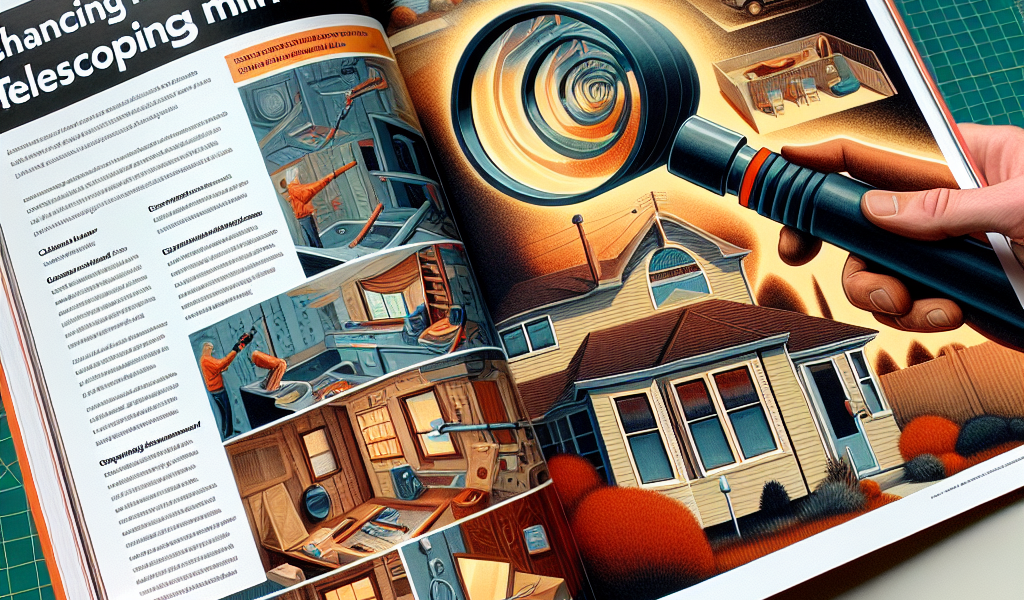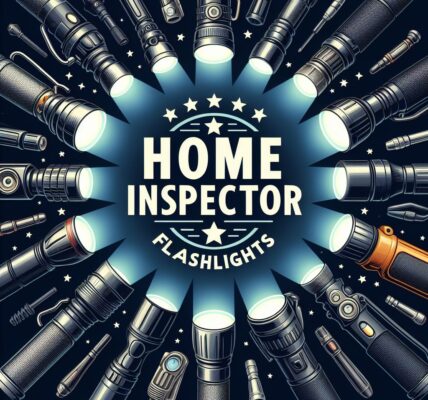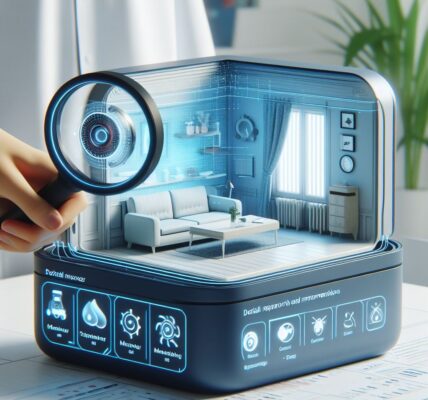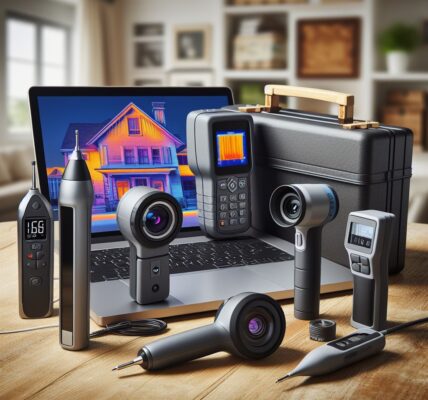Home inspections play a crucial role in identifying potential issues and ensuring the safety and functionality of a property. However, there are often inaccessible or hard-to-reach areas that inspectors struggle to examine thoroughly. This is where telescoping mirrors come into play. These versatile tools enable inspectors to view hidden corners, tight spaces, and ceilings without physically entering them. In this comprehensive guide, we will explore the benefits of using telescoping mirrors for home inspections and provide valuable insights on their features, applications, and best practices. Whether you are a professional home inspector or a homeowner looking to conduct your own inspection, this guide will equip you with the knowledge needed to enhance your inspection process effectively.

Benefits of Using Telescoping Mirrors in Home Inspections
Home inspections are an essential part of the home buying and selling process. They provide buyers with a thorough examination of a property’s condition, helping them make informed decisions about their purchase. Traditionally, home inspectors have relied on visual assessments to identify potential issues. However, these visual inspections often face limitations when it comes to accessing hard-to-reach areas.
Telescoping mirrors offer a practical solution to this problem by providing home inspectors with improved visibility in confined spaces. These versatile tools consist of an extendable handle and a small mirror at the end, allowing for easy inspection of inaccessible areas such as behind appliances, inside ductwork, or under furniture. The benefits of using telescoping mirrors in home inspections are numerous and can greatly enhance the accuracy and efficiency of the inspection process.
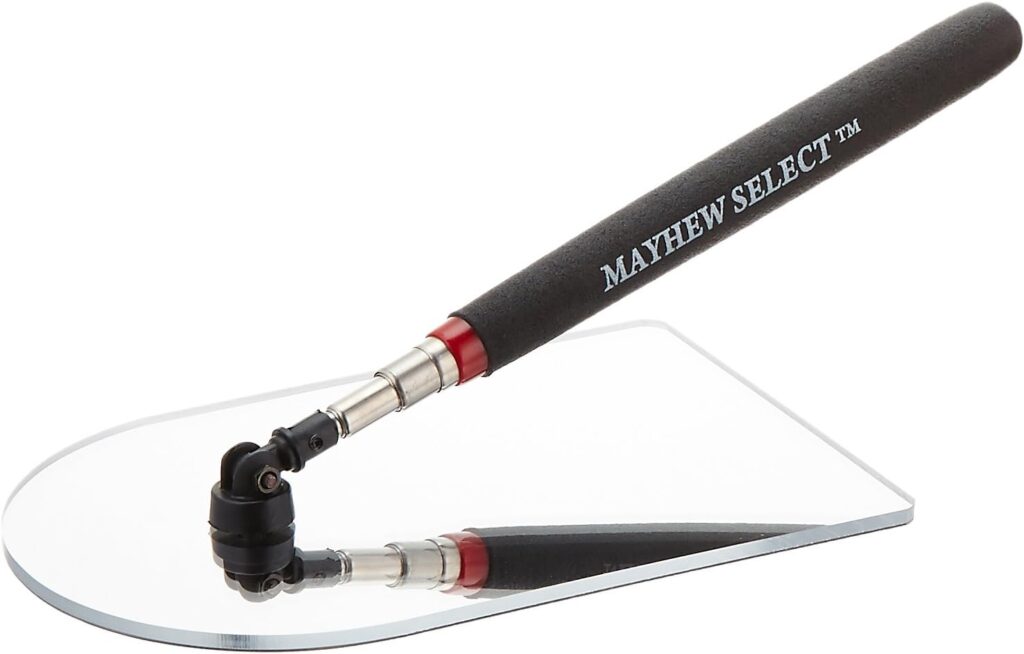
One significant advantage is that telescoping mirrors allow inspectors to examine hidden corners without having to physically crawl or contort themselves into uncomfortable positions. This eliminates the need for unnecessary physical strain during inspections and reduces the risk of injury. By simply extending the mirror into tight spaces, inspectors can easily detect signs of water damage, mold growth, or structural issues that would otherwise go unnoticed.
Another benefit is that telescoping mirrors enable comprehensive examinations within cabinets or behind fixtures that may be securely fastened or difficult to remove. With these tools’ extended reach capabilities, inspectors can visually inspect plumbing connections for leaks or identify any signs of deterioration in piping systems without resorting to destructive methods such as cutting holes in walls or removing fixtures unnecessarily.
Moreover, telescoping mirrors prove particularly useful when assessing attics and crawlspaces—areas prone to housing pests like rodents or insects. By angling the mirror appropriately within these spaces while remaining outside them physically, home inspectors can observe any evidence indicating infestation without coming into direct contact with potentially harmful creatures.
Furthermore, utilizing telescoping mirrors also promotes greater attention to detail during inspections since they allow for close-up scrutiny even in hard-to-see spots. Inspectors can detect minor cracks or defects in inaccessible areas that may lead to significant problems down the line. This level of meticulousness enhances the overall quality of the inspection report and ensures that buyers receive a comprehensive assessment of a property’s condition.
Not only do telescoping mirrors facilitate better inspections, but they also contribute to more efficient use of time during evaluations. With these tools, inspectors can swiftly navigate through different areas, as opposed to spending excessive time moving obstacles or disassembling fixtures just for visibility purposes. The ability to visually assess multiple locations without hindrance expedites the inspection process and allows for greater productivity.
In conclusion, using telescoping mirrors in home inspections offers numerous benefits that significantly enhance the overall evaluation experience. These versatile tools allow inspectors improved access to hard-to-reach areas, provide better visibility within confined spaces, promote attention to detail, and save valuable time during assessments. By incorporating telescoping mirrors into their toolkit, home inspectors can ensure thorough examinations while maintaining safety standards and delivering accurate reports—a win-win situation for both buyers and sellers alike.
How to Choose the Right Telescoping Mirror for Your Home Inspection Needs
Home inspections are an essential part of the home buying and selling process. They provide buyers with valuable information about the condition of a property, helping them make informed decisions. One tool that has proven to be indispensable in this field is the telescoping mirror.
Telescoping mirrors are versatile tools that allow home inspectors to see hidden areas and angles that would otherwise be difficult or impossible to access. By using these mirrors, inspectors can thoroughly examine hard-to-reach places such as behind appliances, underneath furniture, or inside crawl spaces.
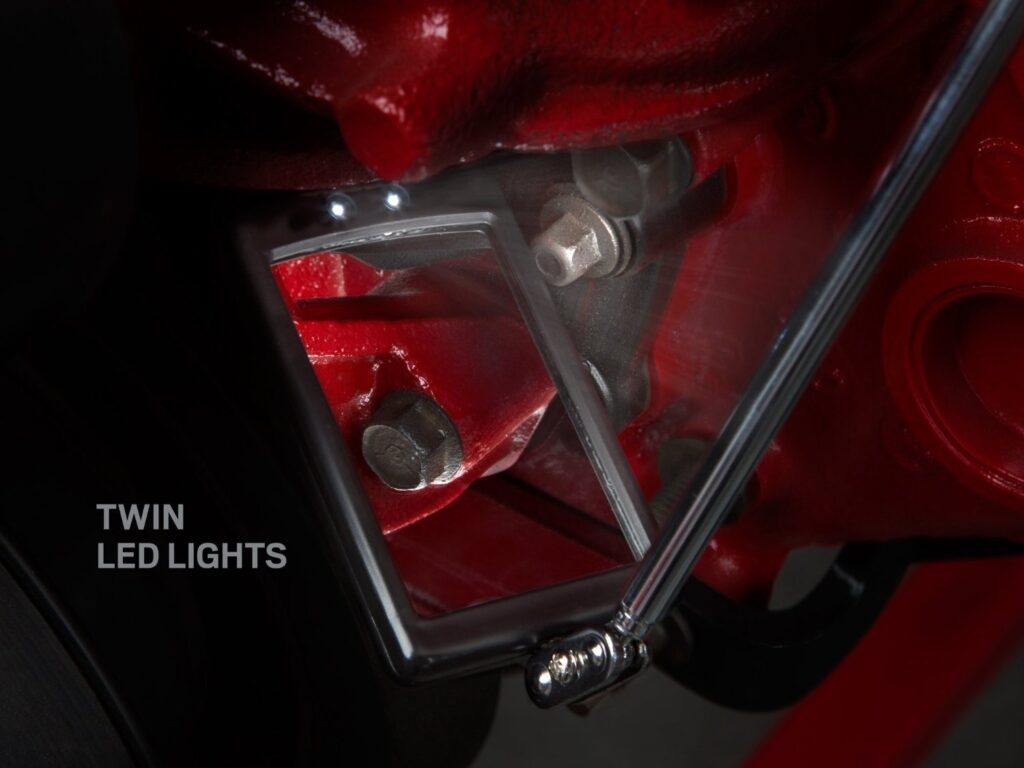
When choosing a telescoping mirror for your home inspection needs, there are several factors to consider. The first consideration is the size and length of the mirror’s extension arm. This determines how far you can reach with the mirror and what areas you will be able to inspect.
If you frequently encounter tight spaces during your inspections, opting for a telescopic mirror with a shorter extension arm may be more practical. On the other hand, if you often find yourself needing extra reach in large rooms or expansive attics, selecting a longer extension arm will ensure maximum coverage.
The second factor to consider is the size and shape of the mirror itself. Rectangular mirrors offer a wider field of view and are ideal for scanning larger surfaces quickly. However, they may not fit into narrow crevices or corners as well as round-shaped mirrors do.
Round mirrors excel at fitting into tight spots due to their compact design but offer a narrower field of view compared to rectangular ones. It is crucial to strike a balance between functionality and versatility when deciding which shape best suits your specific inspection needs.
Another critical aspect when choosing a telescoping mirror is its adjustability features. Look for one with adjustable angles so that you can manipulate it easily depending on various inspection scenarios’ requirements.
Additionally, consider the mirror’s ability to hold its position once adjusted. Some mirrors come with locking mechanisms that allow you to secure the mirror at a specific angle, ensuring stability during inspections.
Durability is also an important factor to consider when choosing a telescoping mirror for home inspections. Since these tools will be exposed to different environments and conditions, it is essential to select one made of sturdy materials such as stainless steel or durable plastic.
Moreover, check if the mirror has a scratch-resistant coating or film. This feature can prolong its lifespan and maintain clear visibility even after prolonged use in potentially abrasive situations.
Lastly, cost should be considered when selecting a telescoping mirror for your home inspection needs. While it may be tempting to opt for cheaper options, investing in a high-quality mirror will pay off in the long run. A reliable and well-constructed tool can withstand years of use without needing frequent replacements.
In conclusion, choosing the right telescoping mirror for your home inspection needs requires careful consideration of various factors. The size and length of the extension arm, shape of the mirror itself, adjustability features, durability, and cost are all crucial aspects that must be taken into account.
By selecting a suitable telescoping mirror with these considerations in mind ,you’ll enhance your ability as a home inspector by effectively accessing hidden areas during inspections .It not only save time but also enables to provide accurate information about a property’ to clients.
Tips and Techniques for Efficiently Using Telescoping Mirrors in Home Inspections
Home inspections are an essential part of the home buying process, as they provide buyers with a detailed assessment of the condition and functionality of a property. Inspectors use various tools to thoroughly examine every nook and cranny, ensuring that nothing goes unnoticed. One such tool that has become increasingly popular in recent years is the telescoping mirror.
Telescoping mirrors are small handheld devices with extendable handles and adjustable angles, allowing inspectors to access hard-to-reach areas without straining or contorting their bodies. These mirrors can be invaluable for examining hidden corners, behind appliances, or underneath furniture. In this comprehensive guide, we will explore some tips and techniques for efficiently using telescoping mirrors during home inspections.

Firstly, it’s important to choose the right type of telescoping mirror for your needs. There are several options available on the market, ranging from basic models with fixed angles to more advanced ones with 360-degree rotation capabilities. Consider factors such as handle length, mirror size, and flexibility when making your selection. Investing in a high-quality telescoping mirror will greatly enhance your inspection process.
Once you have chosen your ideal telescope mirror, it’s crucial to familiarize yourself with its features before starting any inspection. Practice extending and adjusting the angle of the mirror until you feel comfortable maneuvering it effortlessly. This will save you time during actual inspections as you won’t need to fumble around trying to figure out how to position the mirror correctly.
During an inspection, remember that proper lighting is paramount for accurate assessments. Telescoping mirrors often come equipped with built-in LED lights or reflective surfaces that amplify light sources. Make sure you position your body or additional light sources strategically so that they illuminate areas being examined by the mirror effectively.
When using a telescoping mirror in confined spaces like crawlspaces or attics where visibility may be limited due to dust or debris accumulation over time consider wearing protective goggles or masks. Additionally,
Another tip for efficient use of telescoping mirrors is to plan your inspection route in advance. By mapping out which areas you want to examine and in what order, you can avoid unnecessary backtracking or overlooking critical spots. This will maximize your time and ensure a comprehensive assessment of the property.
During an inspection, pay attention to small details that may reveal hidden issues. Telescoping mirrors are excellent tools for spotting signs of water damage, mold growth, or pest infestations behind walls or under sinks. The ability to reach these areas without causing any structural damage is a significant advantage provided by telescoping mirrors.
To ensure accurate documentation of findings during inspections, consider using a camera alongside your telescope mirror. Take pictures of areas where issues are detected as visual evidence that can be referred back to later. These images not only serve as documentation but also assist in communicating potential problems with clients or contractors effectively.
In conclusion, telescoping mirrors have revolutionized the way home inspections are conducted by enabling inspectors to access hard-to-reach areas easily while minimizing physical strain. When selecting a telescope mirror, choose one that suits your specific needs and practice using it before inspections begin.
Proper lighting and protective measures should be considered when working in confined spaces. Planning your inspection route ahead of time ensures efficiency and thoroughness throughout the process.
By paying attention to small details and utilizing other tools such as cameras, inspectors can enhance their effectiveness further.
Overall, incorporating telescoping mirrors into home inspections provides numerous benefits that contribute to more accurate assessments and improved client satisfaction.
Common Challenges Faced During Home Inspections and How Telescoping Mirrors Can Help Overcome Them
Home inspections play a crucial role in the home-buying process, as they help identify potential issues that may impact the value or safety of a property. However, conducting thorough inspections can be challenging due to various factors. This section explores some common challenges faced during home inspections and highlights how telescoping mirrors can effectively overcome them.
One of the most significant challenges inspectors encounter is limited access to certain areas. Many homes have tight spaces such as crawlspaces, attics, or behind appliances that are difficult to reach. Without proper access, inspectors may miss important details or overlook hidden problems.
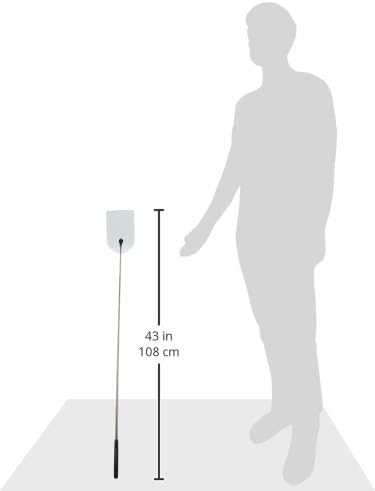
Telescoping mirrors prove to be invaluable tools in such situations by providing extended reach and enabling visual inspection of inaccessible areas. With their adjustable handles and flexible mirror heads, these tools allow inspectors to see around corners, under furniture, or even inside pipes and ducts without having to physically enter cramped spaces.
Moreover, another challenge faced by home inspectors is identifying water damage in hard-to-reach places. Water damage can be particularly problematic as it often goes unnoticed until it has caused substantial harm. Detecting leaks or moisture buildup early on helps prevent costly repairs down the line.
Here again, telescoping mirrors come into play by allowing inspectors to visually examine areas prone to water damage such as ceilings with minimal effort. By angling the mirror correctly and extending its handle into otherwise unreachable spots like above showers or underneath sinks, inspectors gain a comprehensive view of potential problem areas without resorting to invasive measures.
Electrical systems also pose unique challenges during home inspections since inspecting wiring connections behind walls or within junction boxes requires specialized skills and tools. Faulty electrical systems not only jeopardize residents’ safety but also increase fire hazards if left undetected.
Telescoping mirrors offer an effective solution for examining electrical components safely from a distance without requiring physical contact with potentially hazardous elements. Inspectors can use these mirrors when assessing breaker boxes, switches embedded within walls or cabinets, or even hidden wiring connections. The flexibility and extendable nature of telescoping mirrors allow for a comprehensive evaluation of electrical systems without compromising safety.
Another challenge frequently encountered during home inspections is the inspection of roof structures, especially on multi-story buildings. Traditional methods often involve using ladders or binoculars to view rooftops from a distance, but these methods may not provide enough clarity or detail to identify potential issues accurately.
Telescoping mirrors equipped with built-in magnification capabilities offer an ideal solution for inspecting roofs more effectively. Inspectors can use them to focus on specific areas, zoom in for closer examination, and capture detailed images if necessary. These mirrors enable inspectors to assess roofing materials, gutters, chimneys, and other rooftop components in greater detail without putting themselves at risk by climbing onto unstable surfaces.
In conclusion, home inspections face various challenges that can hinder thorough evaluations of properties. However, telescoping mirrors prove invaluable in overcoming these obstacles by providing extended reach into inaccessible spaces like crawlspaces and attics while ensuring visual access through flexible mirror heads. They also enable inspectors to detect water damage early on by examining ceilings and other hard-to-reach places prone to leaks or moisture buildup. Moreover, telescoping mirrors facilitate safe inspection of electrical systems by allowing visual assessment from a distance without direct contact with potentially hazardous elements. Finally, they enhance the effectiveness of roof inspections by offering clear views with built-in magnification capabilities. With these advantages in mind, it becomes evident that integrating telescoping mirrors into the home inspection process significantly enhances its overall efficiency and accuracy
Exploring Different Types of Telescoping Mirrors and Their Applications in Home Inspections
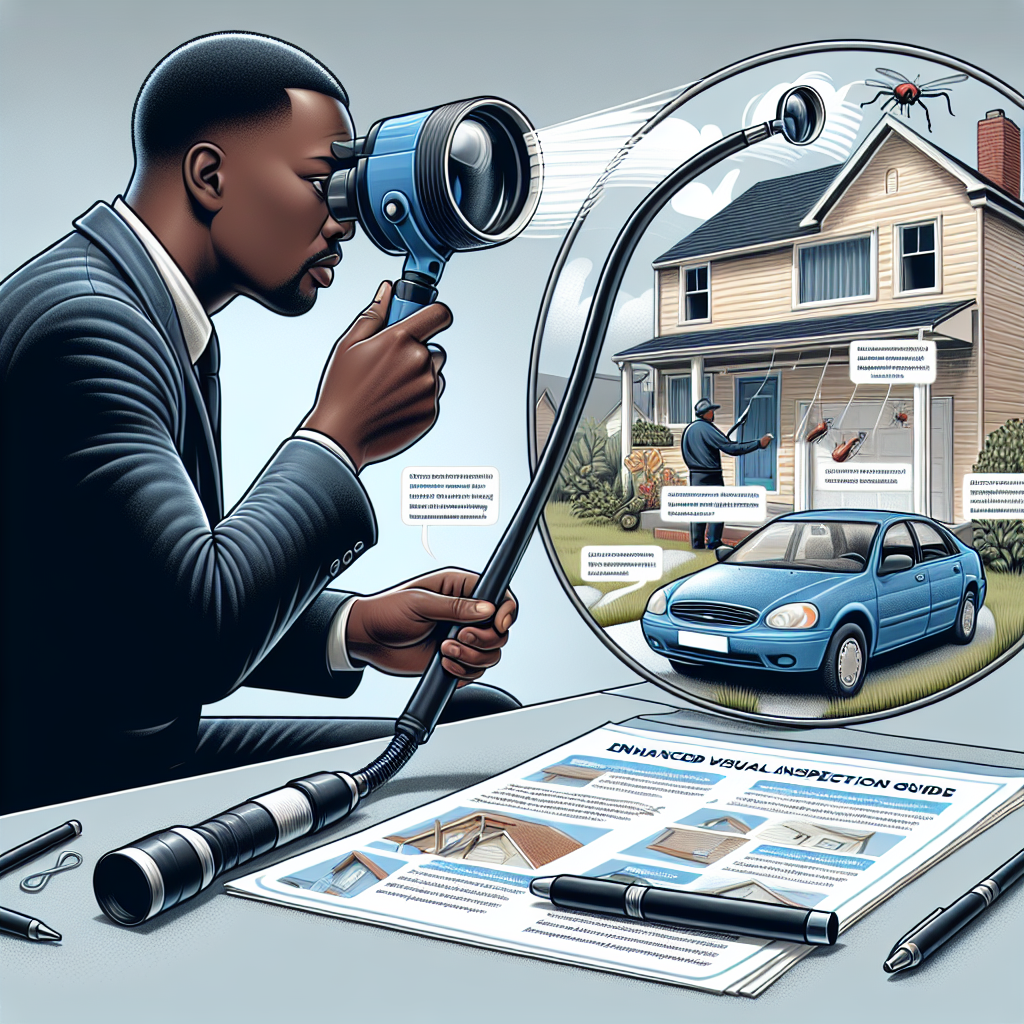
Telescoping mirrors have become invaluable tools for home inspectors, enabling them to examine hard-to-reach areas that would otherwise be inaccessible. These versatile instruments come in various types, each designed for specific applications. In this article, we will delve into the different types of telescoping mirrors commonly used in home inspections and discuss their unique features and benefits.
One popular type of telescoping mirror is the round inspection mirror. This compact tool consists of a circular mirror mounted on an extendable handle. The round inspection mirror is ideal for inspecting tight spaces such as behind appliances or underneath furniture. Its small size allows it to fit into narrow gaps effortlessly while providing a clear view of hidden areas.
Another widely used type is the rectangular inspection mirror, which offers a larger viewing area compared to its round counterpart. The rectangular shape allows inspectors to cover more ground with each sweep, saving time during examinations. It is particularly effective for inspecting ceilings, walls, and floors where a broader perspective is required.
In addition to these basic designs, there are specialized telescoping mirrors tailored to meet specific needs encountered during home inspections. For instance, some mirrors feature built-in LED lights that illuminate dark corners or dimly lit spaces such as attics or crawlspaces. These illuminated mirrors provide enhanced visibility and make it easier for inspectors to identify potential issues even in challenging lighting conditions.
Furthermore, flexible telescopic mirrors offer increased maneuverability when dealing with complex systems or intricate structures like plumbing pipes or electrical wiring within walls. With their bendable shafts that can be adjusted at various angles, these flexible mirrors allow inspectors to peer around corners and reach deep recesses without having to contort themselves physically.
Moreover, magnetic-tip telescoping mirrors add another layer of functionality by allowing inspectors to retrieve small metallic objects or detect hidden magnetic fields. These mirrors prove to be indispensable when examining areas with loose screws, nails, or other metal debris that could pose safety risks if left unattended.
When choosing a telescoping mirror for home inspections, it is crucial to consider the quality of the materials used. Inspectors often encounter demanding environments where durability is paramount. Opting for mirrors constructed from sturdy materials such as stainless steel ensures long-lasting performance and withstands repeated use under challenging conditions.
In conclusion, telescoping mirrors offer invaluable assistance in conducting thorough and efficient home inspections. The variety of types available cater to different inspection requirements and challenges faced by inspectors. From round inspection mirrors ideal for tight spaces to rectangular ones for broader perspectives, each type has its own unique benefits. Additional features like built-in LED lights, flexible shafts, and magnetic tips further enhance their versatility and usability in various scenarios encountered during inspections. By investing in high-quality telescoping mirrors designed specifically for home inspections, inspectors can improve their efficiency while providing clients with more accurate assessments of potential issues within their homes.
Enhancing Safety Measures with Telescoping Mirrors in Home Inspections
Home inspections play a crucial role in identifying potential issues and ensuring the safety of homeowners. With the advancement of technology, various tools have emerged to aid inspectors in their tasks. One such tool that has gained popularity is telescoping mirrors. These versatile devices provide inspectors with enhanced visibility and allow them to access hard-to-reach areas during home inspections.
Telescoping mirrors are compact yet extendable tools equipped with a mirror on one end and a handle on the other. The mirrors can be adjusted at different angles, enabling inspectors to view hidden corners or spaces that are difficult to reach without disassembling fixtures or structures. This flexibility greatly enhances inspection efficiency while minimizing disruptions for homeowners.
One of the primary benefits of using telescoping mirrors is improving safety measures during home inspections. Inspectors often encounter confined spaces, electrical panels, or crawlspaces that pose potential risks. By utilizing these mirrors, they can observe these hazardous areas from a safe distance, reducing the chances of accidents or injuries.
Additionally, telescoping mirrors facilitate thorough examinations of plumbing systems within homes. Plumbing problems often occur in tight spaces under sinks or behind toilets where it is challenging for inspectors to navigate comfortably without proper tools. With their adjustable design, these mirrors enable inspectors to inspect pipes and fittings more comprehensively by providing an unobstructed view.
Furthermore, telescoping mirrors prove invaluable when assessing structural elements such as foundations and ceilings during home inspections. Many structural issues go unnoticed due to limited accessibility; however, these concerns can lead to significant problems if not identified early on. By utilizing telescopic capabilities, inspectors gain an advantage by accessing hidden areas effortlessly without causing any damage.
In addition to safety advantages and improved accessibility, using telescoping mirrors increases inspection accuracy by minimizing human errors commonly encountered when relying solely on visual observations. The ability to maneuver the mirror into tight spots allows for more detailed assessments of areas that might otherwise be overlooked. This comprehensive approach ensures that potential issues are identified and addressed promptly.
Moreover, telescoping mirrors are highly versatile tools that can benefit various industries beyond home inspections. Electricians, for instance, can use these mirrors to inspect wiring connections within circuit breaker panels or to examine electrical components located in hard-to-reach places. HVAC technicians can also utilize them to assess ventilation systems or ductwork without dismantling any fixtures.
Although telescoping mirrors offer many advantages, it is important to note their limitations. These devices may not always provide the same level of clarity as direct visual inspection due to reflections or limited light sources in some areas. Therefore, inspectors should consider using additional lighting equipment when necessary to enhance visibility and ensure accurate assessments.
In conclusion, enhancing safety measures with telescoping mirrors has proven invaluable for home inspections. These compact yet extendable tools allow inspectors to access confined spaces and observe hidden areas without jeopardizing their safety or causing damage during the assessment process. Moreover, they improve accuracy by providing a more detailed view of potential issues that may go unnoticed otherwise. Despite their limitations, these versatile devices have become an essential part of modern home inspections and continue to aid professionals across various industries in conducting thorough examinations efficiently and effectively
Step-by-Step Guide on Conducting a Thorough Home Inspection Using Telescoping Mirrors
When conducting a thorough home inspection, it is essential to have the right tools at hand. One tool that can greatly enhance the effectiveness of inspections is a telescoping mirror. These mirrors provide a unique perspective and enable inspectors to access hard-to-reach areas without causing any damage or disturbance. In this comprehensive guide, we will walk you through the step-by-step process of conducting a thorough home inspection using telescoping mirrors.
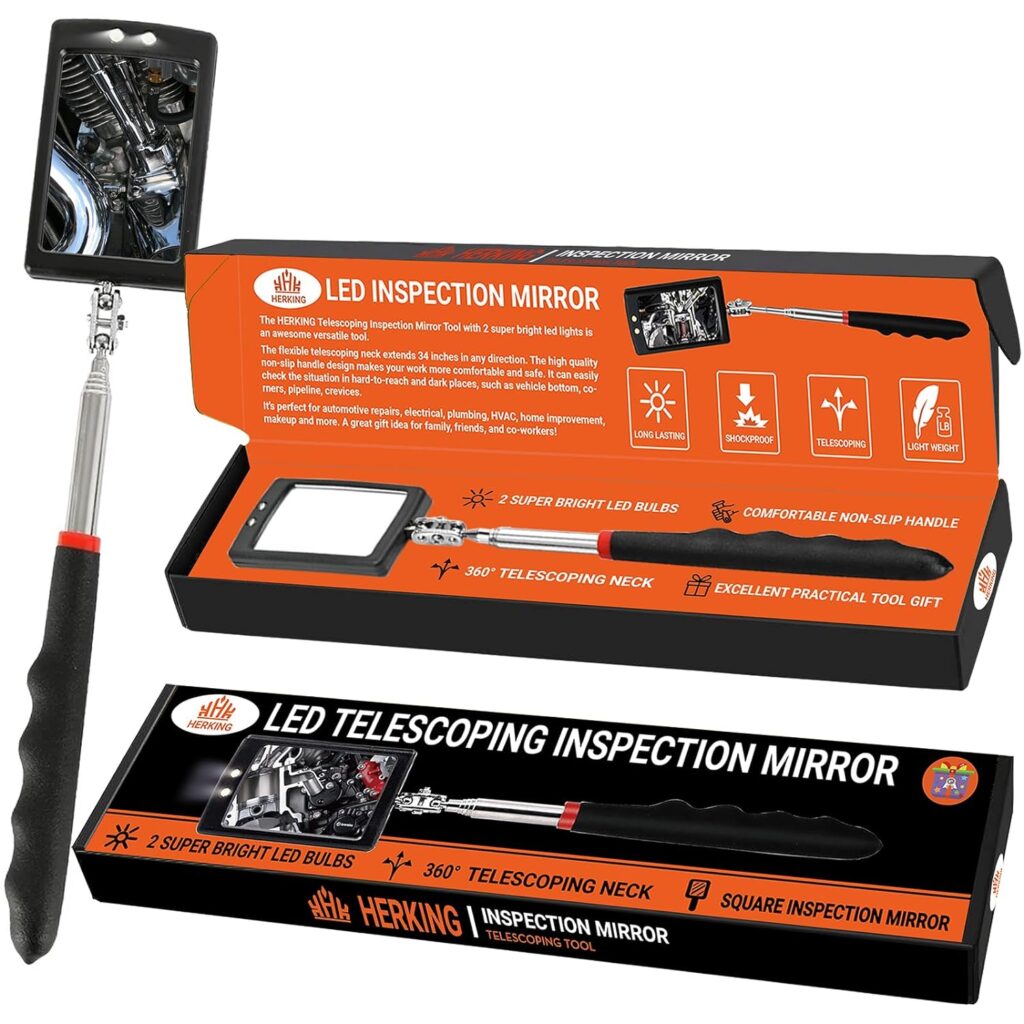
The first step in utilizing telescoping mirrors for home inspections is to identify the specific areas where they would be most beneficial. Typically, these include tight spaces such as behind appliances, under sinks, inside ductwork, and within crawlspaces. By pinpointing these areas beforehand, inspectors can plan their approach and ensure they make full use of the telescoping mirror’s capabilities.
Once the target areas are identified, it is crucial to gather all necessary equipment before beginning the inspection. Apart from the telescoping mirror itself, other tools like flashlights and notepads may also prove handy during this process. By having everything ready beforehand, inspectors can save time and avoid unnecessary delays during their examination.
With all equipment at hand, it’s time to start inspecting each identified area systematically. The key here is to move methodically from one space to another while documenting findings along the way. When using a telescoping mirror in confined spaces like underneath sinks or behind appliances, adjust its length accordingly so that you can view each angle thoroughly.
As an inspector uses a telescoping mirror in various locations throughout the property, attention should be given to identifying potential issues or concerns that could affect its overall functionality or safety standards. This includes checking for loose electrical connections behind appliances or inspecting ductwork for signs of damage or blockages that may impact airflow within HVAC systems.
Furthermore,
inspectors should pay close attention to any signs of moisture or water damage, as these can often be hidden in hard-to-reach areas. Using a telescoping mirror to access crawlspaces and behind walls allows inspectors to identify potential leaks or mold growth that may not be visible otherwise. By catching such issues early on, homeowners can avoid expensive repairs down the line.
Throughout the inspection process, it is important for inspectors to remain vigilant and thorough in their assessments. This includes using the telescoping mirror to check for any structural defects or wear and tear that may compromise the integrity of the property. By visually examining key areas like foundation walls and support beams, inspectors can identify any signs of deterioration or damage that need immediate attention.
As the inspection draws to a close, it is essential for inspectors to document their findings accurately. Detailed notes should be taken regarding any issues discovered during the examination, along with supporting photographs taken using the telescoping mirror. This documentation will serve as crucial evidence when discussing concerns with clients or negotiating repairs with contractors.
In conclusion,
telescoping mirrors are valuable tools that greatly enhance home inspections by providing access to hard-to-reach areas without causing unnecessary damage or disturbance. By following this comprehensive guide on conducting a thorough home inspection using telescoping mirrors, inspectors can ensure they leave no stone unturned while assessing a property’s condition. From identifying potential problems hidden in confined spaces to documenting findings systematically, these mirrors prove invaluable throughout every step of an inspection process
Best Practices for Maintaining and Cleaning your Telescoping Mirror for Long-lasting Use
Telescoping mirrors are essential tools in the field of home inspections. These mirrors allow inspectors to access hard-to-reach areas, such as behind walls or underneath furniture, without having to physically crawl into those spaces. As with any tool, proper maintenance and regular cleaning are crucial to ensure their long-lasting use. In this comprehensive guide, we will discuss the best practices for maintaining and cleaning your telescoping mirror.
Firstly, it is important to note that telescoping mirrors come in different designs and materials. Some may have a plastic handle while others have a metal one. The type of material used will determine the appropriate cleaning method.
For plastic handles, simply wiping them down with a soft cloth dampened with mild soap and water should suffice. It is advisable to avoid using harsh chemicals or abrasive cleaners as they may damage the surface of the plastic handle.
On the other hand, if your telescoping mirror has a metal handle, you can clean it by using a mixture of warm water and mild dish soap. Gently scrubbing the handle with a soft brush or sponge will help remove any dirt or grime that has accumulated over time. Once cleaned, rinse thoroughly with water and dry with a soft cloth.
Regardless of whether your mirror has a plastic or metal handle, it is vital to regularly inspect it for any signs of wear or damage. Check for loose screws or joints that may need tightening before use. This preventive measure ensures that your telescoping mirror remains sturdy during inspections and prevents accidents from occurring.
The reflective surface of the telescopic wand also requires attention when maintaining these tools properly. To keep the mirror clear and free from debris, start by removing any dust particles using compressed air or gentle blowing motions. Be cautious not to blow too forcefully as this might cause scratches on its delicate surface.
Next comes an essential step – cleaning off fingerprints or smudges. To do this, use a soft lint-free cloth and some glass cleaner specifically formulated for mirrors. Apply the glass cleaner to the cloth and gently wipe the mirror’s surface in circular motions. Avoid spraying directly onto the mirror as excess liquid may seep into crevices or damage other parts of the tool.
If you encounter stubborn marks that do not come off easily, dampen a cotton swab with isopropyl alcohol and carefully rub them away. It is crucial to exercise caution while using alcohol-based cleaners as they can potentially damage certain types of coatings on mirrors.
After cleaning, make sure to thoroughly dry the mirror before retracting it into its handle. Leaving any moisture behind may lead to corrosion or mold growth over time.
Proper storage is another aspect that should not be overlooked when maintaining your telescoping mirror. Store it in a clean, dry area where it won’t get knocked around or exposed to extreme temperatures. Keep it away from direct sunlight or sources of heat, which could cause warping or discoloration.
By following these best practices for maintaining and cleaning your telescoping mirror, you can ensure its long-lasting use and accurate performance during home inspections. Regular maintenance will not only extend its lifespan but also contribute to efficient and effective inspections by keeping your tools in optimal condition at all times.
Case Studies: Real-life Examples of How Telescoping Mirrors Have Improved Home Inspection Processes
Home inspections are crucial when it comes to buying or selling a house. They help identify any hidden issues, ensuring that both parties are well-informed before making any decisions. In recent years, the use of telescoping mirrors has become increasingly popular in the field of home inspection. These mirrors provide inspectors with a tool to easily access hard-to-reach areas and enhance their ability to assess a property’s condition accurately.
Case studies have shown how telescoping mirrors have revolutionized the home inspection process. One such example is the case of a potential buyer interested in an old Victorian-style house. The inspector utilized a telescoping mirror to examine the crawl space beneath the property, revealing signs of water damage and termite infestation that would have otherwise gone unnoticed. Armed with this knowledge, the buyer was able to negotiate for repairs before finalizing the purchase.
In another instance, an inspector used a telescoping mirror during an assessment of an apartment building’s roof. By extending the mirror’s handle above his head, he was able to inspect areas that were difficult to reach without risking personal safety or needing additional equipment like ladders or scaffolding. This allowed for more efficient inspections and saved time for both parties involved.
Telescoping mirrors also prove invaluable when evaluating electrical systems within homes or commercial buildings. Inspectors can utilize these tools by extending them into tight spaces behind walls or inside circuit breaker panels where wiring connections may be located. This enables thorough examination without requiring excessive disassembly, thus minimizing disruption and reducing potential hazards associated with accessing these areas.
Furthermore, inspectors often encounter challenges when trying to evaluate plumbing systems thoroughly—especially pipes concealed within walls or under floors—without resorting to invasive measures like drilling holes or removing sections of drywall unnecessarily. Telescoping mirrors offer a solution by providing visibility in these tight spaces without causing unnecessary damage or disturbances.
In addition to residential properties, telescoping mirrors have proven beneficial during commercial building inspections as well. For instance, a business owner looking to purchase an old warehouse was concerned about the condition of its support beams and foundation. By using a telescoping mirror, the inspector was able to examine areas under the floor and inside walls, identifying structural issues that required immediate attention. This information empowered the buyer to negotiate repairs or adjust their offer accordingly.
Moreover, telescoping mirrors have also proven useful in inspecting chimneys and ventilation systems. Inspectors can use these mirrors to assess the internal conditions of these components without having to access rooftops or dismantle structures unnecessarily. This allows for more efficient inspections while reducing potential safety risks associated with working at heights.
In conclusion, case studies highlight how telescoping mirrors have enhanced home inspection processes by providing inspectors with improved visibility in hard-to-reach areas. These tools have been particularly effective in uncovering hidden issues within crawl spaces, electrical systems, plumbing networks, and structural elements of both residential and commercial properties. By facilitating thorough evaluations without causing unnecessary damage or requiring additional equipment like ladders or scaffolding, telescoping mirrors save time for all parties involved while ensuring comprehensive assessments are conducted before making important real estate decisions.
Understanding the Limitations of Telescopic Mirror Usage in Various Aspects of a Home Inspection
Home inspections play a vital role in the process of buying or selling a home. They provide an objective assessment of the condition of a property, identifying any issues or potential problems that need to be addressed. In recent years, telescoping mirrors have emerged as valuable tools for home inspectors, allowing them to access hard-to-reach areas and enhance their ability to detect hidden defects. However, it is important for inspectors to understand the limitations of telescopic mirror usage in various aspects of a home inspection.
One area where telescoping mirrors can be particularly useful is in inspecting roofs. Roofs are often difficult to access and inspect closely due to their height and steep angles. Telescoping mirrors enable inspectors to get a better view of areas such as flashing around chimneys or vents, which are prone to leaks and water damage. By using these mirrors, inspectors can detect signs of wear and tear that may not be visible from ground level.
Another aspect where telescopic mirrors can prove invaluable is in examining crawl spaces. Crawl spaces are typically dark and cramped areas beneath houses that are prone to moisture buildup and pest infestations. Inspectors must thoroughly examine these spaces for signs of structural damage or other issues. Telescoping mirrors allow them to visually inspect all parts of the crawl space without having to physically enter it themselves, reducing the risk of injury or exposure.
Telescoping mirrors also find applications in plumbing inspections. Plumbing systems are intricate networks hidden behind walls and under floors, making it challenging for inspectors to assess their condition fully. By using telescopic mirrors, they can gain better visibility into tight corners or behind fixtures such as toilets or sinks without causing extensive damage during the inspection process.
Furthermore, electrical inspections can benefit greatly from telescopic mirror usage as well since electrical components often reside within confined spaces like breaker boxes or junction boxes inaccessible by traditional means alone.
Despite these advantages, there are limitations associated with using telescopic mirrors during a home inspection. One limitation is the restricted field of view they provide. While these mirrors can extend several feet, they are still limited in their ability to capture an entire space or area. Inspectors must be mindful of this limitation and supplement their inspections with other tools or techniques to ensure a comprehensive assessment.
Another limitation is the potential for image distortion due to the curved surface of telescopic mirrors. This distortion can affect the accuracy and clarity of what inspectors see through the mirror, making it necessary for them to exercise caution when interpreting what they observe.
Additionally, there may be situations where using a telescoping mirror is simply not feasible or practical. For example, if access points are too narrow or obstructed, inspectors may need alternative methods to examine certain areas.
In conclusion, while telescoping mirrors offer numerous advantages in enhancing various aspects of home inspections, it is important for inspectors to understand their limitations as well. These mirrors enable easier examination of hard-to-reach areas such as roofs, crawl spaces, plumbing systems, and electrical components but come with constraints related to field of view and potential image distortion. By recognizing these limitations and employing additional inspection methods when necessary, home inspectors can use telescoping mirrors effectively as part of a comprehensive assessment process that ensures transparency and accuracy in evaluating property conditionsIn conclusion, utilizing telescoping mirrors in home inspections can significantly enhance the efficiency and effectiveness of the process. These versatile tools allow inspectors to access hard-to-reach areas, providing a comprehensive view of potential issues and hazards within a property. The guide provided offers valuable information on selecting the right telescoping mirror, proper usage techniques, and tips for maximizing its benefits during home inspections. By incorporating telescoping mirrors into their toolkit, inspectors can ensure thorough evaluations and ultimately improve overall inspection outcomes.
